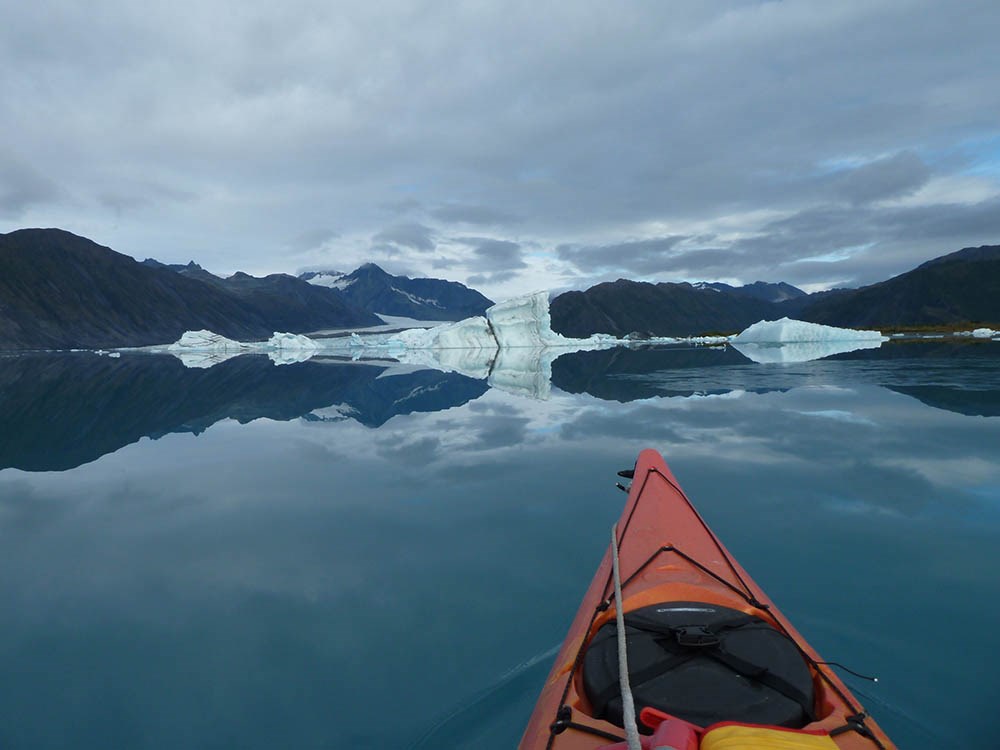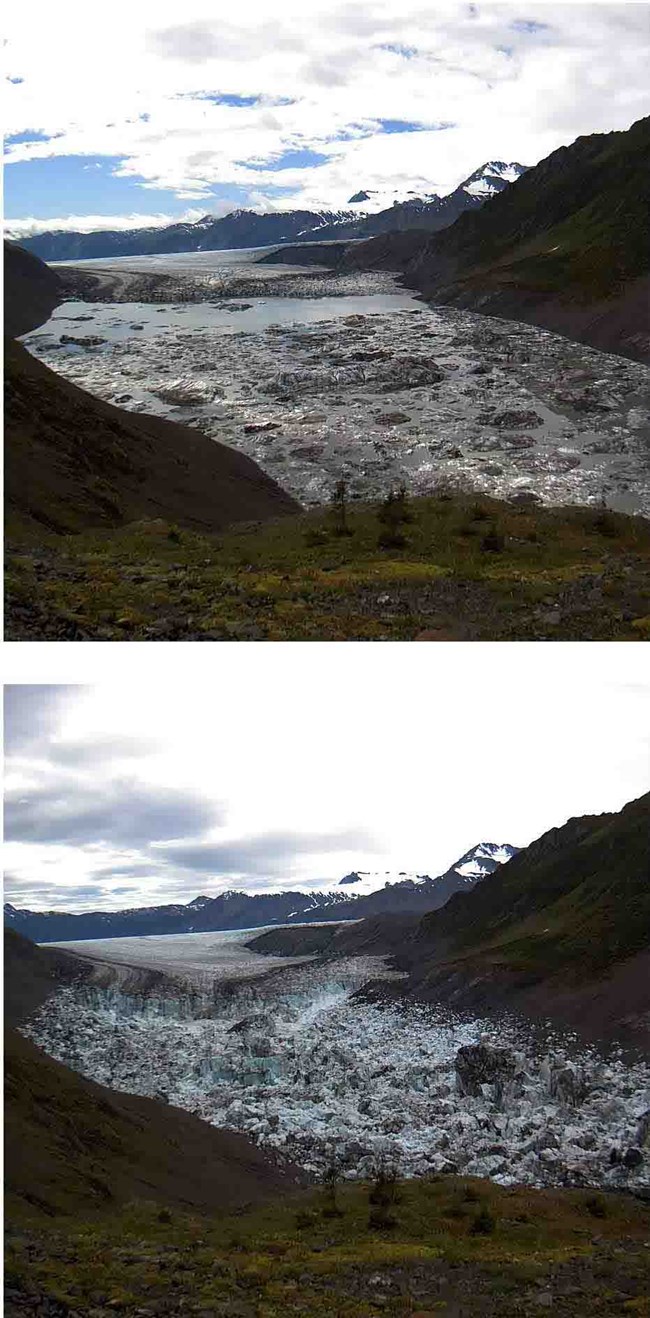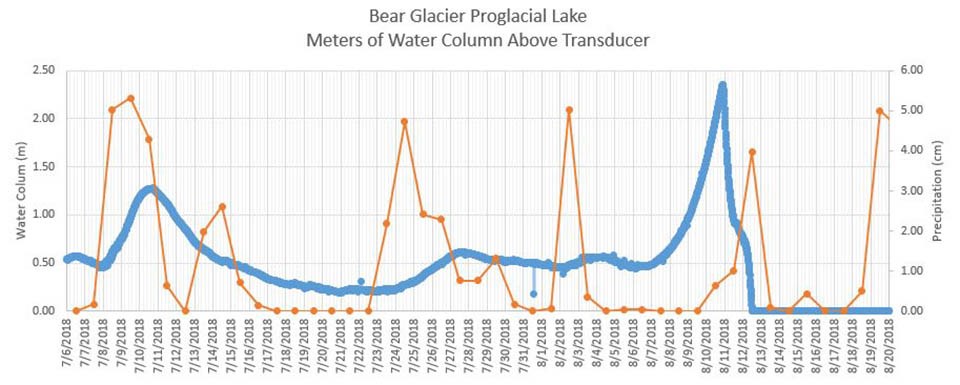Part of a series of articles titled Alaska Park Science, Volume 18, Issue 1, Understanding and Preparing for Alaska's Geohazards.
Article
Risk and Recreation in a Glacial Environment: Understanding Glacial Lake Outburst Floods at Bear Glacier in Kenai Fjords National Park
Gabriel Wolken, Alaska Division of Geological and Geophysical Surveys

Photo courtesy of NPS/D. Kurtz, September 2015.
The dynamic forces at work in coastal southcentral Alaska where glaciers, mountains, and oceans meet provide rich habitats, scenic vistas, and outstanding recreational opportunities. These extreme environments can also result in geohazards such as landslides, floods, and other glacier-related risks. Here we present our efforts to understand a reoccurring glacial lake outburst flood affecting a popular recreational area in Kenai Fjords National Park and preliminary results from a glacial lake outburst flood that occurred in August 2018.
Kenai Fjords National Park is located on the southeastern edge of the Kenai Peninsula in southcentral Alaska. It is characterized by rugged mountains, a jagged coastline, and large dynamic glaciers that cover nearly half of the park. Most of these glaciers descend from the Harding Icefield, a mass of ice covering nearly 700 square miles (1,800 km2). Visitors come from around the world to see, explore, and experience the glaciers. Of particular interest is Bear Glacier, the longest glacier in the park, situated between the tidewater glaciers that occupy the fjords in the south and land-locked Exit Glacier in the north. Bear Glacier is one of four lake-terminating glaciers in the park and is the closest one to the city of Seward, making it the most accessible to visitors. The unnamed proglacial lake where Bear Glacier terminates is a surreal landscape where calm turquoise waters full of glacial silt invite visitors to kayak and stand-up paddleboard (SUP) among towering icebergs, surrounded by steep mountain slopes and the terminus of Bear Glacier itself (Figure 1). Local commercial outfitters have capitalized on the remarkable recreational opportunities provided by this striking environment by providing day or overnight kayaking trips and SUP adventures, accessing the lake by helicopter, jet boat, or landing craft.
In recent years, marketing of these activities near Bear Glacier has increased and become more widespread via print periodicals (Shivley 2013, Parsons 2016), often with fabulous cover photos highlighting recreational activities at Bear Glacier as the cover story (Dickerson 2016, Parsons 2016), and through online social media (both commercial and personal) resulting in increased interest in this area. One local kayak guiding company reported that people have walked into their office with a magazine photo of a person on a SUP in front of a glacier and stated: “I want to do this!” The same glacial environment that attracts people also poses risks. Sudden, dynamic events such as iceberg calving, calving-induced seiches (waves), and glacial lake outburst floods (GLOFs) are natural occurrences in these environments. Bear Glacier, in particular, is becoming well known among Seward’s summer residents for its GLOFs.
GLOFs occur when water stored on, under, adjacent to, or within a glacier is suddenly released, causing water levels in the rivers and lakes down-stream of the glacier to increase rapidly. These releases often result in floods that are one or two orders of magnitude greater than precipitation-driven events. GLOFs occur at various locations on the Kenai Peninsula including Skilak, Snow, and Bear glaciers as well as many other locations around Alaska (Post and Mayo 1971).

Seven miles (12 km) above the terminus of Bear Glacier an unnamed lake occupies an ice-free tributary valley (Figure 2). Bear Glacier blocks the natural drainage path of this valley and creates a lake. Every few years the lake empties, sending enormous volumes of water under Bear Glacier and down to its terminus, where it floods the proglacial lake. According to anecdotal reports from backcountry outfitters guiding in the proglacial lake at Bear Glacier, the resultant high water levels can persist for a period of several days to several weeks before subsiding to normal levels. Although known to occur, we do not understand the timing or the causes that trigger the drainage events that cause these floods.
Knowledge of this present-day glacier-dammed lake on Bear Glacier pre-dates establishment of Kenai Fjords National Park. Marcus identified this lake in an inventory of glacier-dammed lakes in the Chugach and Kenai Mountains in a 1968 report, but there was no discussion of GLOFs associated with this lake at that time (Marcus 1968). This may have been due to little human-presence and/or use in front of the glacier, likely because the terminus of Bear Glacier extended farther out, filling most of the present-day proglacial lake.
Up until 2008, GLOFs and their potential risks at Bear Glacier were of limited concern to park managers, due to low visitation and low park staff presence in the proglacial lake. As local tour companies began to guide visitors into the proglacial lake more frequently, they started to observe a pattern of floods occurring every 2-3 years. Icebergs often choked the mouth of the outflow river between the lake and the bay, preventing access by jet boat or landing craft. Occasionally, water bypassed the river and ran over the moraine that separates the lake and the bay. With increased visitor use came increased awareness of the phenomenon, as well as increased risk to people and property.
In August 2014, a GLOF occurred at Bear Glacier that raised water levels until they eroded the moraine separating the lake and outlet from the ocean. This resulted in a full breach of the moraine and allowed silt-laden, freshwater from the lake to pour directly into the bay. This breach was immediately followed by a dramatic drop in the water levels in the proglacial lake. Although no one was injured during this outburst event, there were reports that kayaks and a canoe were washed out into the bay. Fortunately, this flood occurred near the end of the visitor season, a time of reduced recreational use in the proglacial lake. Although the presence of people allowed detection of the event, it also created risk.
While our awareness of this glacier-dammed lake and the GLOFs it creates has increased, many questions related to the mechanisms, timing, and frequency of this drainage remain. In 2012, Kenai Fjords park staff and researchers at the University of Montana attempted to (1) identify historical changes in the water level of the glacier-dammed lake and (2) measure the timing and frequency of a real-time drainage event to better quantify potential hazards associated with the GLOF (Wilcox et al. 2014). This work resulted in a history of changes to the glacier-dammed lake area and an inventory of evidence of drainage events from the last decade. The researchers’ recommendations included continued study of the glacier-dammed lake through remotely sensed and on-site data collection and analysis.

In 2017, Kenai Fjords National Park and State of Alaska Division of Geological and Geophysical Surveys researchers installed a satellite-telemetered camera at the glacier-dammed lake. This timelapse camera takes a daily photo and, within a couple hours, emails it to us via satellite (Figure 3). This method and equipment allow us to monitor the filling and drainage of the lake without risk of losing the equipment during a drainage and provide us with near-real time information of the status of the lake. These observations can be used with elevation data to help us to calculate water levels and volume.
Although we would like to measure water depth directly from the glacier-dammed lake itself, there are numerous challenges to installing any equipment in the lake. Two previous attempts to do so resulted in loss of equipment, likely due to ice scouring or strong currents that formed during the drainage. Also, installation requires traversing steep, loose scree slopes to access the edge of the lake. Finally, it is difficult to calculate the difference in lake levels at the time of installation and the time of removal. That information is critical to prevent the equipment from sitting on the bottom of the lake where it could get buried in sediment, damaged by ice, or become inaccessible due to high water levels.
A second timelapse camera was installed next to the proglacial lake near the glacier terminus. Photos from this basic SLR camera (requiring manual downloading) document flooding and calving activity that could occur in the event of a GLOF. A pressure transducer was installed near this timelapse camera site to measure water depth throughout the summer. This data will help us understand how long it took for the water to reach the proglacial lake after it started draining from the glacier-dammed lake and other seasonal water level dynamics in the proglacial lake.
At the time of the first camera installation, the glacier-dammed lake had little water in it and grounded blocks of ice were distributed well above the water line. The last time the lake was observed by park staff prior to the camera installation was about a year earlier, on July 16, 2016. At that time, the water levels in the lake were higher than in June 2017 and all of the calved chunks of ice were floating, allowing us to infer that there was an undetected drainage event at some time during the previous year. Over the course of the first summer, the daily photos allowed us to observe and document the filling of the basin and formation of the glacier-dammed lake.
From the satellite-delivered photos, we observed the glacier-dammed lake fill throughout the 2017 summer, freeze in the winter, and continue to fill for most of summer 2018. On August 8, 2018 we observed a slight decrease in water levels in the glacier-dammed lake. On August 9, an additional decrease in water levels alerted us to the beginning of a GLOF. Based on analysis of the timelapse photos, water levels in the glacier-dammed lake decreased by 50-65 feet (15-20 m) per day during the first days of the drainage, releasing at least 2,600 Olympic-sized swimming pools of water per day into the proglacial lake below.
Water levels in the proglacial lake rose nearly 1.5 feet (0.5 m) per day for a total of 6.5 feet (2 m) in 96 hours, with the fastest rate of rise occurring between August 9-11 (Figure 4).

On August 11, a pilot observed that water in the proglacial lake had breached the moraine that separates the freshwater lake and outlet from the marine waters of Resurrection Bay. This allowed water to bypass a large section of the normal outflow channel (which subsequently dried up and remained unnavigable the remainder of the season) and flow over the moraine and directly into the bay. The erosion of the moraine was so deep that water taxis, small skiffs, and jet boats were able to enter the lake by boating over the moraine at the location of the breach during a higher tide. This was the only boat access into the proglacial lake; the normal outlet was completely dry or too shallow for navigation. Data from the pressure transducer indicated that the water level began to drop during the morning of August 11, two days after the glacier-dammed lake started to drain, likely due to this more direct route into the ocean. On August 13, water levels dropped below the level of the pressure transducer, preventing us from knowing the subsequent rate of lake lowering and the actual minimum water level. When we retrieved the equipment on August 25, the water level was approximately one meter below the pressure transducer. Based on this observation, it is likely that the water levels dropped approximately 11 feet (3.4 m).
By monitoring the daily timelapse photos, we were able to detect a decrease in the glacier-dammed lake levels early in the drainage event. This allowed us to notify the National Weather Service’s Alaska-Pacific River Forecast Center who put out a timely flood alert for this area. This early observation provided sufficient time for commercial guides to plan for the event and prevented one group from certain loss of an equipment cache.
Within a week of the GLOF, an NPS flight was able to collect aerial photography that will allow us to create highly detailed topographic maps of the drained lake basin. The pre- and post-drainage topographic data will allow us to accurately calculate water storage volume in the glacier-dammed lake. In combination with photographic and lake-level data from the proglacial lake, this will allow us to refine our volume estimate of the GLOF and improve our ability to predict flood magnitudes and rates during subsequent GLOFs.
Glaciers and the landscapes they create are beautiful, dynamic places to behold and experience as a distant observer, skilled adventurer, or inquisitive scientist. Ice falls, calvings, collapses, and outburst floods can and do occur without warning. People should always use caution when playing, working or traveling around glaciers.
Kenai Fjords and State of Alaska researchers will continue to study and monitor the Bear Glacier glacier-dammed lake to better understand hydrological processes leading to GLOFs, and increase awareness about glacier-related hazards in and around the park.
References
Dickerson, S. 2016.
Cold World. Transworld Surf: The Alaskan Issue, May 2016.
Marcus, M. 1968.
Effects of glacier-dammed lakes in the Chugach and Kenai Mountains. In, The Great Alaska Earthquake of 1964 Hydrology (publication 1603), National Academy of Sciences, Washington D.C., pp. 326-347.
Taylor, W. 2012.
Exploring the Frozen Frontier. SUP Magazine, Winter 2012. Available at:
https://www.supthemag.com/videos/from-the-mag-exploring-the-frozen-frontier/ (accessed 12/11/2018)
Parsons, R. 2016.
Liquid Adventures: Glacial SUP tours in Alaska. SUP Magazine Available at:
https://www.supthemag.com/gear/shop-talk/liquid-adventures-glacial-sup-tours-in-alaska/ (accessed 12/11/2018)
Post, A. and L. R. Mayo, L.R. 1971.
Glacier Dammed Lakes and Outburst Floods in Alaska. Hydrologic Investigations Atlas HA-455. Anchorage, Alaska. U.S. Geological Survey, Denver CO.
Shivley, D. 2013.
Paddling with icebergs in Seward, Alaska. Easy Reader News Available at:
https://easyreadernews.com/paddling-with-ice-bergs-in-seward-alaska/ (accessed 12/11/2018)
Wilcox, A., A. Wade, and E. Evans. 2014.
Drainage events from a glacier-dammed lake, Bear Glacier, Alaska: Remote sensing and field observations. Geomorphology 220: 41-49.
Last updated: December 30, 2019
